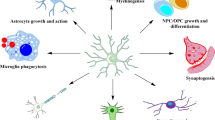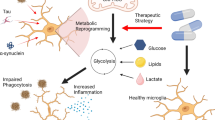Abstract
Microglia are the major inflammatory cells in the central nervous system and become activated in response to brain injuries such as ischemia, trauma, and neurodegenerative diseases including Alzheimer’s disease (AD). Moreover, activated microglia are known to release a variety of proinflammatory cytokines and oxidants such as nitric oxide (NO). Minocycline is a semisynthetic second-generation tetracycline that exerts anti-inflammatory effects that are completely distinct form its antimicrobial action. In this study, the inhibitory effects of minocycline on NO and prostaglandin E2 (PGE2) release was examined in lipopolysaccharides (LPS)-challenged BV2 murine microglial cells. Further, effects of minocycline on inducible nitric oxide synthase (iNOS) and cyclooxygenase-2 (COX-2) expression levels were also determined. The results showed that minocycline significantly inhibited NO and PGE2 production and iNOS and COX-2 expression in BV2 microglial cells. These findings suggest that minocycline should be evaluated as potential therapeutic agent for various pathological conditions due to the excessive activation of microglia.
Similar content being viewed by others
References
Amin, A. R., Attur, M. G., Thakker, G. D., Patel, P. D., Vyas, P. R., Patel, R. N., Patel, I. R., and Abramson, S. B., A novel mechanism of action of tetracyclines: effects on nitric oxide synthases.Proc. Natl. Acad. Sci. USA, 93, 14014–14019 (1996).
Arvin, K. L., Han, B. H., Du, Y., Lin, S. Z., Paul, S. M., and Holtzman, D. M. Minocycline markedly protects the neonatal brain against hypoxic-ischemic injury.Ann. Neurol., 52, 54–61 (2002).
Bauer, M. K., Lieb, K., Schulze-Osthoff, K., Berger, M., Gebicke-Haerter, P. J., Bauer, J., and Fiebich, B. L., Expression and regulation of cyclooxygenase-2 in rat microglia.Eur. J. Biochem., 243, 726–731 (1997).
Blasi, E., Barluzzi, R., Bocchini, V., Mazzolla, R., and Bistoni, F. Immortalization of murine microglial cells by a v-raf/v-myc carrying retrovirus.J. Neuroimmunol., 27, 229–237 (1990).
Bocchini, V., Mazzolla, R., Barluzzi, R., Blasi, E., Sick, P., and Kettenmann, H., An immortalized cell line expresses properties of activated microglial cells.J. Neurosci. Res., 31, 616–621 (1992).
Boje, K. M. and Arora, P. K., Microglial-produced nitric oxide and reactive nitrogen oxides mediate neuronal cell death.Brain Res., 587, 250–256 (1992).
Brown, D. R., Microglia and prion disease.Microsc. Res. Tech., 54, 71–80 (2001).
Chao, C. C., Hu, S., Molitor, T. W., Shaskan, E. G., and Peterson, P. K., Activated microglia mediate neuronal cell injury via a nitric oxide mechanism.J. Immunol., 149, 2736–2741 (1992).
Davies, S. R., Cole, A. A., and Schmid, T. M., Doxycycline inhibits type X collagen synthesis in avian hypertrophic chondrocyte cultures.J. Biol. Chem., 271, 25966–25970 (1996).
De Clerck, Y. A., Shimada, H., Taylor, S. M., and Langley, K. E., Matrix metalloproteinases and their inhibitors in tumor progression.Ann. N Y Acad. Sci., 732, 222–232 (1994).
Dickson, D. W., Lee, S. C., Mattiace, L. A., Yen, S. H., and Brosnan, C., Microglia and cytokines in neurological disease, with special reference to AIDS and Alzheimer’s disease.Gila, 7, 75–83 (1993).
Du, Y., Ma, Z., Lin, S., Dodel, R. C., Gao, F., Bales, K. R., Triarhou, L. C., Chernet, E., Perry, K. W., Nelson, D. L., Luecke, S., Phebus, L. A., Bymaster, F. P., and Paul, S. M. Minocycline prevents nigrostriatal dopaminergic neurode-generation in the MPTP model of Parkinson’s disease.Proc. Natl. Acad. Sci. USA, 98, 14669–14674 (2001).
Egger, T., Schuligoi, R., Wintersperger, A., Amann, R., Malle, E., and Sattler, W., Vitamin E (alpha-tocopherol) attenuates cyclo-oxygenase 2 transcription and synthesis in immortalized murine BV-2 microglia.Biochem. J., 370, 459–467 (2003).
Gabler, W. L. and Creamer, H. R. Suppression of human neutrophil functions by tetracyclines.J. Periodontal Res., 26, 52–58 (1991).
Gao, H. M., Jiang, J., Wilson, B., Zhang, W., Hong, J. S., and Liu, B., Microglial activation-mediated delayed and progressive degeneration of rat nigral dopaminergic neurons: relevance to Parkinson’s disease.J. Neurochem., 81, 1285–1297 (2002).
Gebicke-Haerter, P. J., Microglia in neurodegeneration: molecular aspects.Microsc. Res. Tech., 54, 47–58 (2001).
Green, L. C., Wagner, D. A., Glogowski, J., Skipper, P. L., Wishnok, J. S., and Tannenbaum, S. R., Analysis of nitrate, nitrite, and [15N]nitrate in biological fluids.Anal. Biochem., 126, 131–138 (1982).
He, Y., Appel, S., and Le, W., Minocycline inhibits microglial activation and protects nigral cells after 6-hydroxydopamine injection into mouse striatum.Brain Res., 909, 187–193 (2001).
McGeer, P. L., Itagaki, S., Boyes, B. E., and McGeer, E. G., Reactive microglia are positive for HLA-DR in the substantia nigra of Parkinson’s and Alzheimer’s disease brains.Neurology, 38, 1285–1291 (1988).
McGuire, S. O., Ling, Z. D., Lipton, J. W., Sortwell, C. E., Collier, T. J., and Carvey, P. M., Tumor necrosis factor alpha is toxic to embryonic mesencephalic dopamine neurons.Exp. Neurol., 169, 219–230 (2001).
Milner, R. and Campbell, I. L., The extracellular matrix and cytokines regulate microglial integrin expression and activation.J. Immunol., 170, 3850–3858 (2003).
Nelson, P. T., Soma, L. A., and Lavi, E. Microglia in diseases of the central nervous system.Ann. Med., 34, 491–500 (2002).
Patel, R.N., Attur, M.G., Dave, M.N., Patel, I.V., Stuchin, S.A., Abramson, S.B. and Amin A.R. A novel mechanism of action of chemically modified tetracyclines: inhibition of COX-2- mediated prostaglandin E2 production.J. Immunol., 163, 3459–3467 (1999).
Pocock, J. M. and Liddle, A. C., Microglial signalling cascades in neurodegenerative disease.Prog. Brain Res., 132, 555–565 (2001).
Raine, C. S., Multiple sclerosis: immune system molecule expression in the central nervous system.J. Neuropathol. Exp. Neurol., 53, 328–337 (1994).
Ramamurthy, N., Greenwald, R., Moak, S., Scuibba, J., Goren, A., Turner, G., Rifkin, B., and Golub, L., CMT/Tenidap treatment inhibits temporomandibular joint destruction in adjuvant arthritic rats.Ann. N. Y. Acad. Sci., 732, 427–430 (1994).
Rogers, J., Luber-Narod, J., Styren, S. D., and Civin, W. H., Expression of immune system-associated antigens by cells of the human central nervous system: relationship to the pathology of Alzheimer’s disease.Neurobiol. Aging, 9, 339–349 (1988).
Ryan, M. E. and Ashley, R. A., How do tetracyclines work?Adv. Dent. Res., 12, 149–151 (1998).
Salimi, K., Moser, K. V., Marksteiner, J., Reindl, M., and Humpel, C., GDNF and TGF-beta1 promote cell survival in serum-free cultures of primary rat microglia.Cell Tissue Res., 312, 135–139 (2003).
Sanchez Mejia, R. O., Ona, V. O., Li, M., and Friedlander, R. M., Minocycline reduces traumatic brain injury-mediated caspase- 1 activation, tissue damage, and neurological dysfunction.Neurosurgery, 48, 1393–1399; discussion 1399–1401 (2001).
Scali, C., Prosperi, C., Vannucchi, M. G., Pepeu, G., and Casamenti, F., Brain inflammatory reaction in an animal model of neuronal degeneration and its modulation by an anti-inflammatory drug: implication in Alzheimer’s disease.Eur. J. Neurosci., 12, 1900–1912 (2000).
Schulz, J. B., Matthews, R. T., and Beal, M. F., Role of nitric oxide in neurodegenerative diseases.Curr. Opin. Neurol., 8, 480–486 (1995).
Shimizu, T. and Wolfe, L. S., Arachidonic acid cascade and signal transduction.J. Neurochem., 55, 1–15 (1990).
Tikka, T., Usenius, T., Tenhunen, M., Keinanen, R., and Koistinaho, J., Tetracycline derivatives and ceftriaxone, a cephalosporin antibiotic, protect neurons against apoptosis induced by ionizing radiation.J. Neurochem., 78, 1409–1414 (2001).
Uitto, V. J., Firth, J. D., Nip, L. and Golub, L. M., Doxycycline and chemically modified tetracyclines inhibit gelatinase A (MMP-2) gene expression in human skin keratinocytes.Ann. N. Y.Acad. Sci., 732, 140–151 (1994).
Author information
Authors and Affiliations
Corresponding author
Rights and permissions
About this article
Cite this article
Kim, SS., Kong, PJ., Kim, BS. et al. Inhibitory action of minocycline on lipopolysaccharide-lnduced release of nitric oxide and prostaglandin E2 in BV2 microglial cells. Arch Pharm Res 27, 314–318 (2004). https://doi.org/10.1007/BF02980066
Received:
Issue Date:
DOI: https://doi.org/10.1007/BF02980066




